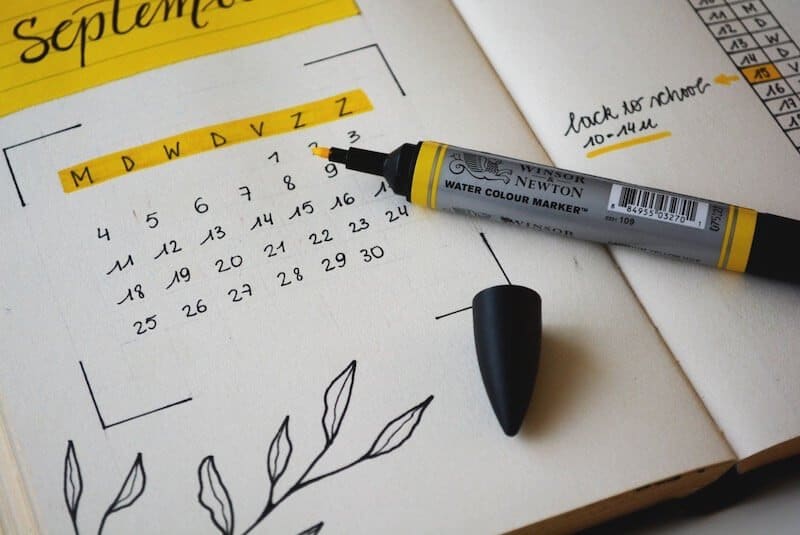Stuck at home because of the pandemic lockdown?
Same here. My company issued the work-from-home order to all its employees.
Some might take this opportunity to stream Netflix and catch up on some missed episodes while working. Others might dread being stuck with their kids 24/7.
Sure, there are challenges associated with working from home. It might take a bit of time for someone to readjustment to a new routine.
But you and I are going to be even more productive working from home.
Here are the top 7 tips to stay focused and productive when working from home.
[lwptoc labelShow=”show” labelHide=”hide” hideItems=”0″ width=”auto” float=”none”]
The Benefits of Working from Home
The number one benefit of working from home is that you’re free of constant interruption by your coworkers and supervisors.
When you’re working in an office environment, the value you bring to the company is not always and necessarily, your performance output. You being in the office is simply “convenient” for your coworkers and supervisors because they can easily interrupt and ask you questions or give you tasks at the last minute.
I’m not saying it doesn’t happen in a virtual working environment. We do have access to each other via email, instant messaging, and video conference calls. But for the most part, the likelihood of constant interruption is a lot less when working from home.
This means you can exercise a lot more control over your schedule and block a chunk of hours for a specific task, without interruption.
Instead of juggling multiple requests and tasks, you can instead structure your work so that you can tackle them one at a time.

1. Work in Short Bursts
This brings me to the concept of working in short bursts to have a high output performance on your work. Work on a single task, or series of tasks that are similar in nature and work them in a batch for a set period of time.
Why work in short bursts? We can only hold our attention for so long. Parkinson’s law says work expands to fill the time available for its completion. That means if you don’t give yourself a limited time span to work on a task, it’ll drag on for a long time. The longer something takes, the more your attention and willpower wanes.
So before even you start on a task, estimate how long you’ll work on that task and focus on it 100% while working.
I do a bunch of types of tasks in a day: data-entry and administrative tasks, translation, writing, outreach, and planning, to name a few. I assign myself 30, 60, or 90 minutes to work on one of these tasks. I give myself more time for creative work such as writing and planning. For the tasks that don’t require much thinking, like data entry, I do them as fast as possible and fire away on the keyboard.
2. Practice “Clean Focus”
When the time is up, stop working on that task (Unless it’s creative work and you’re “in the zone”). Detach yourself completely. Perhaps take a quick break and move onto another task that’s completely different in nature.
Often times, as adults we carry mental baggage from a lot of things that happen during a day. For example, thinking about the quarrel you had with your significant another while at work, or worrying about your work when you’re with your family.
One way to practice having a mental “on and off switch” is to perform tasks no longer than the time allocated for it. And when it’s time to switch the task or take a break from it, do so with a clear state of mind. That’s how you practice “clean focus.”
That is why you want to single-task in short intervals. This will help you to start and finish a task quickly, and you’ll be more clear-headed.
3. Use the Pomodoro Technique
Pomodoro means tomato in Italian and the Pomodoro Technique is a popular time management technique. Set a tomato-shaped timer to 25 minutes and focus on one task. When the timer goes off, stop whatever you’re doing and take a 5-minute break. Then repeat the cycle.
Of course, you can use whatever timer you want. Here’s an online Pomodoro timer.
Personally, I don’t strictly stick to the 25-minute rule because I have a general idea of how long each of my tasks is going to take and what the appropriate breakpoint would be.
I use an app called Toggl to keep track of all of my tasks. Because I’ve been doing that for so long I have enough data to estimate how long my tasks are going to take.
4. Follow a Routine
Are you a bit intimated by the thought of having to create and follow a new routine, now that you’re stuck working from home?
Whether you’ve realized or not, you’ve been following a routine way before the pandemic lockdown.
You get up, maybe skip breakfast, commuted to work, and get a cup of coffee and cookie on your way. You arrive at the office, not too early but also not so late that you become the last person to walk into the office.
Does this sound like you? Do you know someone like this? It’s still a routine, and it is optimized for waking up at the latest time possible, getting caffeine, and not being embarrassed.

When you’re working from home, what routine are you going to follow? What will your routine be optimized for?
If you think in those terms, then you obviously want to follow a routine that optimized for productivity and happiness.
If your company issued the work-from-home order, this is your chance to straighten up your daily routine and improve your focus, energy level, and quality of your life.
Working from home has allowed me to shave off the time that I otherwise would have spent on the commute and start my day feeling even more refreshed.
I wake up at the same time every morning including the weekend, I exercise just as much if not more than before the pandemic outbreak (Here’s a good fitness YouTube video to watch and follow if you want to do quick cardio).
I start and end my workday with a checklist. I do not begin or end my workday without ticking those checkboxes off. This enables me to completely detach work from home life. I can’t afford an extra desk for work but I do use a separate computer for work and another for personal use.
5. Get Your Basics in Order
This goes without saying but you want to get your basics in order. Eat healthily, get quality sleep, exercise adequately, and have some social interaction, virtually if possible.
Be careful not to slip into the lifestyle of staying up late and sleeping in. If you ever fall to that trap, remember to get back on track quickly by resuming the routine that has worked for you before.
6. Work in Public
Even with the best intentions, sometimes we might fall by the wayside. Sometimes, we are just tired and not motivated.
There’s one human drive that’ll overdrive your exhaustion and lack of motivation. It’s avoiding embarrassment.
If you slack off or miss a day of work at the office without a good reason, there’s a real consequence. Not only will you receive a disciplinary warning, but your boss and coworkers might start to think of you incompetent (of course, they shouldn’t think less of you as a person, but get my point). You show up to work because you want the guaranteed salary, but also because you do not want to be embarrassed. You do not want to stand out negatively.
To prevent yourself from slacking off at home, work in public.
What I mean is that either work where people can see you (like live stream yourself working) or share your work progress with somebody.
Set a deadline for what you want to accomplish, and tell someone about it. You’re more likely to follow-through on your words when you do not want to embarrass yourself.

7. Recommended Reading on Focus, Attention, and Self-Discipline
Here is the list of books on the topics of focus, attention, and self-discipline that you should check out. In no particular order, I listed them with some quotes from each book.
Indistractable: How to Control Your Attention and Choose Your Life
by Nir Eyal
- “While we can’t control the feelings and thoughts that pop into our heads, we can control what we do with them.”
- “We can cope with uncomfortable internal triggers by reflecting on, rather than reacting to, our discomfort.”
- Distractions are not distractions. It’s how we respond to them.”
Deep Work: Rules for Focused Success in a Distracted World
by Cal Newport
- “Who you are, what you think, feel, and do, what you love—is the sum of what you focus on.”
- “Efforts to deepen your focus will struggle if you don’t simultaneously wean your mind from a dependence on distraction.”
- “To produce at your peak level you need to work for extended periods with full concentration on a single task free from distraction. Put another way, the type of work that optimizes your performance is deep work.”

Atomic Habits: An Easy & Proven Way to Build Good Habits & Break Bad Ones
by James Clear
- “Every action you take is a vote for the type of person you wish to become. No single instance will transform your beliefs, but as the votes build up, so does the evidence of your new identity.”
- “You do not rise to the level of your goals. You fall to the level of your systems.”
- “You should be far more concerned with your current trajectory than with your current results.”
The Shallows: What the Internet Is Doing to Our Brains
by Nicholas Carr
- “We don’t constrain our mental powers when we store new long-term memories. We strengthen them. With each expansion of our memory comes an enlargement of our intelligence. The Web provides a convenient and compelling supplement to personal memory – but when we start using the Web as a substitute for personal memory, by bypassing the inner processes of consolidation, we risk emptying our minds of their riches.”
- “Experiments show that just as the brain can build new or stronger circuits through physical or mental practice, those circuits can weaken or dissolve with neglect.”
- “The Web provides a convenient and compelling supplement to personal memory, but when we start using the Web as a substitute for personal memory, bypassing the inner processes of consolidation, we risk emptying our minds of their riches.”
Recommended Tools
- Toggl – a simple time tracker to keep track of your tasks and projects. Extended features include team time tracking and project management.
- Harvest – time tracker with invoicing capability. Great for freelancers and agencies.
- Hubstaff – online timesheets and time tracking. It can also track your team members’ locations and take snapshots of what they’re working on.
- Freedom – block distracting websites for a set period of time
It’s Your Turn
I’m sure it’s not easy to manage anxiety and stress during the time of uncertainty like this one we’re going through. My hearts go out to the families of victims and to those whose financial situation became more challenging from the COVID-19 pandemic.
But those of you who are fortunate enough to keep the job and now having to adjust your lifestyle — what changes will you try to stay productive while working from home?
Is it working in short intervals? Creating a new routine? Or sharing your work progress and goals? Let me know in the comment below.
Join the Newsletter FREE
Get Exclusive Productivity Tips That I Only Share with Subscribers


